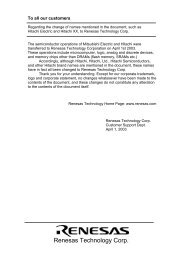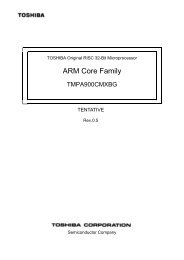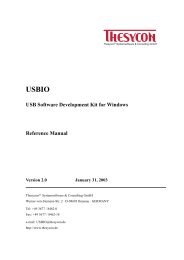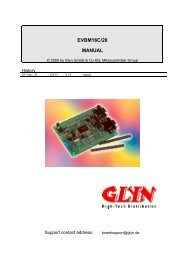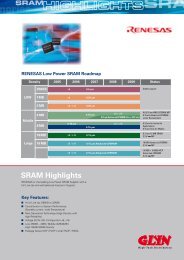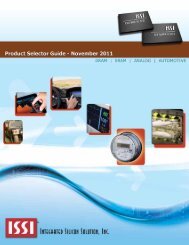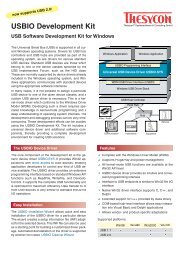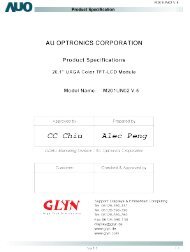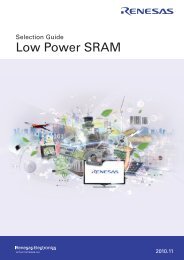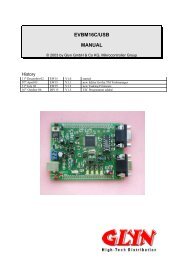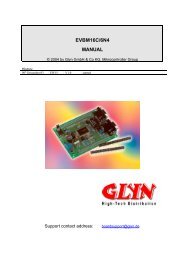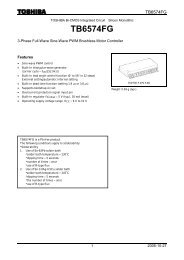GAS 86xyB Digital Gas Sensor Platform - Glyn
GAS 86xyB Digital Gas Sensor Platform - Glyn
GAS 86xyB Digital Gas Sensor Platform - Glyn
You also want an ePaper? Increase the reach of your titles
YUMPU automatically turns print PDFs into web optimized ePapers that Google loves.
<strong>GAS</strong> <strong>86xyB</strong><br />
<strong>Digital</strong> <strong>Gas</strong> <strong>Sensor</strong> <strong>Platform</strong>
It‘s time to get ready for<br />
in the smallest<br />
best performance<br />
package
<strong>Gas</strong> sensing becomes digital with the<br />
Micronas mySENS ® technology<br />
Micronas gas sensors are based on a<br />
unique and proprietary technology called<br />
mySENS. The special feature distinguishing<br />
Micronas devices from others is their<br />
special CCFET setup. The CCFET technology<br />
(Capacitive Coupled Field Effect<br />
Transistor) is the way, our sensors detect<br />
gas concentration changes in the ambient<br />
air for a broad variety of applications.<br />
For the detection of a target gas, a gas-sensitive<br />
layer is applied on a suspended gate<br />
that is mounted on top of a silicon chip.<br />
If this layer comes into contact with molecules<br />
of the target gas it responds with a<br />
change of its surface potential. As shown<br />
in the figure below, the gas-sensitive layer<br />
is capacitively coupled to a large floating<br />
electrode which is connected to the floating<br />
gate of a conventional MOSFET (Metal Oxide<br />
Semiconductor Field-Effect Transistor).<br />
<strong>Gas</strong>-Sensitive<br />
Layer<br />
<strong>GAS</strong> <strong>86xyB</strong> Chip<br />
Floating Electrode<br />
Any gas-induced change of the gassensitive<br />
layer‘s surface potential is detected<br />
by the MOSFET and digitally processed<br />
by the integrated electronics.<br />
What makes this way of gas detection so<br />
special? The interaction between the gassensitive<br />
layer and ambient gas molecules<br />
is a reversible dynamic process. This process<br />
takes place at room temperature allowing<br />
low-power, unheated operation<br />
for many gas species. All of this occurs<br />
without wear of the gas-sensitive layer.<br />
By using different gas-sensitive layers,<br />
Micronas gas sensors are able to detect<br />
specific target gases like nitrogen dioxide<br />
(NO 2 ), ammonia (NH 3 ), hydrogen (H 2 )<br />
and volatile organic compounds (VOC).<br />
Suspended Gate<br />
Air Gap<br />
Read-out<br />
Transistor<br />
<strong>GAS</strong> <strong>86xyB</strong><br />
All in one package<br />
<strong>GAS</strong> <strong>86xyB</strong> is the latest generation of<br />
multi-parametric sensor platforms for<br />
gas detection based on the pioneering<br />
mySENS technology from Micronas.<br />
The capabilities of the <strong>GAS</strong> <strong>86xyB</strong> platform<br />
go far beyond the measurement<br />
of a single gas species. Embedded into<br />
Micronas’ CMOS manufacturing technology,<br />
<strong>GAS</strong> <strong>86xyB</strong> includes two individual<br />
CCFET gas sensing devices, a temperature<br />
sensor, a relative humidity sensor,<br />
and electronic components, such as amplifiers,<br />
digital signal processing unit (DSP),<br />
as well as memory on one single chip.<br />
By choosing the appropriate gas-sensitive<br />
layers for the two independent gas sensing<br />
devices, the sensor platform is factory-tailored<br />
to a specific sensing task. A<br />
serial peripheral interface (SPI) is capable<br />
of addressing each sensor independently<br />
and provides digital values, proportional to<br />
the measurement results. The factory-calibrated<br />
integrated temperature and relative<br />
humidity sensors can be used for crosssensitivity<br />
compensation leading to reli-<br />
VDDH, VSSH TEST<br />
VDD, VSS<br />
R<br />
Heater<br />
<strong>Gas</strong><br />
<strong>Sensor</strong><br />
<strong>Gas</strong><br />
<strong>Sensor</strong><br />
Relative Humidity<br />
<strong>Sensor</strong><br />
Temperature<br />
<strong>Sensor</strong><br />
M<br />
U<br />
X<br />
A D<br />
HW<br />
Settings<br />
EEPROM<br />
<strong>Digital</strong><br />
Signal<br />
Processing<br />
Power-on Reset<br />
Oscillator<br />
Register<br />
SPI<br />
DVN<br />
SCK<br />
CSN<br />
SDO<br />
SDI<br />
<strong>GAS</strong> <strong>86xyB</strong><br />
able gas detections. They can also be used<br />
for independent temperature and relative<br />
humidity measurement purposes.<br />
The sensor platform allows an electric performance<br />
check via an intelligent self-test<br />
function to guarantee accurate operation.<br />
For this function, a dedicated voltage level<br />
can be applied to the floating gate allowing<br />
the stimulation of an output voltage<br />
change without the presence of a target<br />
gas. Furthermore, an integrated heater<br />
provides the capability of heating the<br />
device. This may be needed for special<br />
operating conditions or for thermal refreshment<br />
e.g. in case of volatile organic<br />
compounds (VOC).<br />
Another striking feature of the <strong>GAS</strong> <strong>86xyB</strong><br />
is its unique package. The sensor platform<br />
is available in an open-cavity QFN package<br />
with the dimensions of only 6 mm ×<br />
8 mm × 1.4 mm (length × width × height).<br />
An implemented polytetrafluorethylene<br />
(PTFE) filter on the open cavity avoids<br />
particle contamination of the sensor elements.
Our features, your benefits How the <strong>GAS</strong> <strong>86xyB</strong> meets<br />
your business needs<br />
• Two independent gas sensor devices<br />
• Robust against overdose exposure<br />
• Integrated temperature sensor<br />
• Integrated relative humidity sensor<br />
• Electronic self-test capability<br />
• <strong>Digital</strong> signal processing<br />
• Integrated EEPROM<br />
• <strong>Digital</strong> SPI interface<br />
• Integrated heating option<br />
• 2.7 to 3.6 V operating voltage<br />
• Measurement ranges from approx.<br />
100 ppb up to 1% gas concentration<br />
(exact values depend on the target gas)<br />
• Operates from −40 °C up to 85 °C<br />
ambient temperature<br />
• Operates from 5% up to 95% relative<br />
humidity<br />
• Low current consumption (10 years)<br />
• Small 8 mm × 6 mm × 1.4 mm QFN<br />
sensor package with integrated PTFE<br />
particle filter<br />
Micronas mySENS gas sensors represent<br />
a new versatile sensor technology serving<br />
major industrial and automotive trends.<br />
Building<br />
• Comfort and energy efficiency in building<br />
automation: heating, ventilation,<br />
and air conditioning (HVAC), indoor Air<br />
Quality (iAQ)<br />
• Early fire detection (small size and<br />
improved fire detection with less false<br />
alarms)<br />
Automotive<br />
• Cabin air quality: farming (NH3 ), truck<br />
exhaust (NO2 ), or gasoline exhaust (H2 )<br />
• HVAC control (heating, ventilation, and<br />
air conditioning)<br />
• Wind-screen fogging prevention<br />
Consumer<br />
• Portable fire detection and air quality<br />
sensors (e.g. in smartphones, tablets,<br />
white goods)<br />
Safety / Industrial<br />
• NH3 leakage detection (alternative<br />
coolant)<br />
• H2 leakage detection (fuel cell facilities,<br />
fuel cell vehicles, hydrogen installation)<br />
USB demo kit<br />
Get to know the <strong>GAS</strong> <strong>86xyB</strong><br />
With an easy-to-use plug-and-play USB solution,<br />
Micronas provides the fastest way<br />
to begin the evaluation of the <strong>GAS</strong> <strong>86xyB</strong><br />
with mySENS technology. You only need<br />
a PC with a USB port and the appropriate<br />
LabVIEW software with graphical<br />
user interface (GUI), which can be downloaded<br />
from the Micronas Service Portal<br />
https://service.micronas.com. After installation,<br />
you are able to set up the complete<br />
<strong>GAS</strong> <strong>86xyB</strong> sensor, to read out and to<br />
store the measurement values on your PC.
Company Profile<br />
Micronas (SIX Swiss Exchange: MASN) is known and recognized in the automotive and<br />
industrial business as a reliable global acting partner for intelligent, sensor-based system<br />
solutions. Micronas offers a variety of Hall sensors and embedded controllers for smart<br />
actuators for automotive and industrial applications, such as drive trains, chassis frames,<br />
engine management and convenience functions.<br />
Micronas serves all major automotive electronics customers worldwide, many of them<br />
in continuous partnerships seeking joint success. While the holding company is headquartered<br />
in Zurich (Switzerland), operational headquarters are based in Freiburg (Germany).<br />
Currently, the Micronas Group employs around 900 persons.<br />
Please visit www.micronas.com for more information on Micronas and its products. For<br />
further questions on the Micronas gas sensor technology please contact us via email at<br />
mySENS@micronas.com.<br />
Micronas GmbH<br />
Hans-Bunte-Strasse 19 I 79108 Freiburg I Germany<br />
Phone +49 761 517-0 I Fax +49 761 517 2174 mySENS@micronas.com<br />
www.micronas.com Order No. PR-2020-3E First published in May 2012



